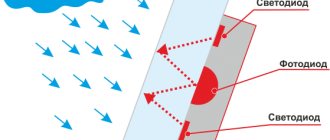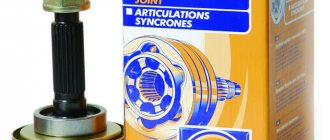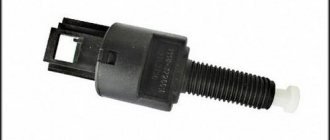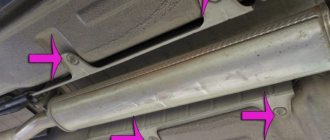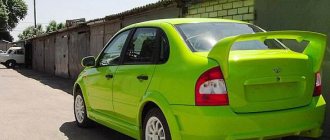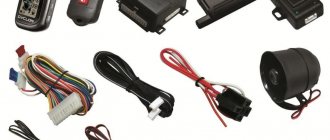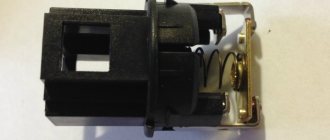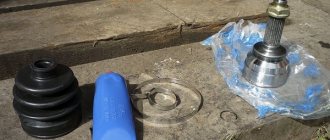July 15, 2016 Lada.Online 53 893 6
Many modern Lada cars (for example, Granta, Kalina, Vesta or XRAY) have a standard rain sensor, which is installed from the factory. On machines that do not have this option, you can install it yourself. Let's look at the features of connecting the DDA rain sensor on different Lada models.
setting up the rain sensor VAZ 2190 Lada Granta
Adjusting the standard rain sensor of the VAZ 2190 Lada Granta Luxury
The most expensive versions of the car have an automatic windshield wiper control system depending on the presence of raindrops on the windshield, which are detected thanks to a sensor attached to the rear view mirror of the car.
The system is operational only when the ignition is on. Sensitivity can be adjusted using a switch located directly on the sensor. There are 4 positions: 0 - off, 4 - maximum sensitivity. To activate the system, move the windshield wiper switch lever to the “continuous operation” position. The brushes will make one stroke, which indicates that the system is working properly. Now the rain sensor will monitor the presence of water in its coverage area on the windshield. If water gets in, the brushes will work until a signal is received from the sensor that there is no moisture.
In the event of a malfunction of the rain sensor system, the wiper blades operate using the standard intermittent mode algorithm.
The rain sensor is also combined in one housing with a light sensor, thanks to which the automatic control of external lighting allows you to turn on and off the side lights and low beam headlights depending on the current light level. For example, if you enter a dimly lit tunnel, the system will automatically turn on your headlights and headlights.
Replacing the sensor. The rain and light sensor cannot be repaired, but only replaced with another one. For example, when replacing a windshield, the sensor also changes, because by removing it, the original characteristics, that is, sensitivity, will be lost. Therefore, it is better to make a replacement from an official dealer, because the process of installing a sensor or glass is quite complicated so that it can be mistaken when installing it on an adhesive base. Thus, there is a risk of damaging the sensor without qualified installation.
Source
Sensor design, operating features
A light sensor (hereinafter referred to as DS) is a microcontroller board in a plastic housing. In the center of the module there is a lens for “capturing” the light flux (photocell).
The operating principle of the DS is as follows: when the switch lever is in the “Auto” position, the sensor determines the brightness of the light beam. As soon as the actual brightness indicator is below the “programmed” range, the low beam and dashboard lights are automatically turned on.
The DS is automatically deactivated when the brightness level increases.
Page 45
the windows turn on when the key in the ignition switch is turned to position I
.
position.
The windshield wipers and washers are switched off.
II – intermittent relay switched on
windshield wiper operating pressure.
Unfixed position.
operating mode of the windshield wiper.
Fixed position.
IV – low speed enabled
windshield cleaner.
Fixed position.
windshield wiper height.
Fixed position.
VI – towards you, wash is on
windshield body.
Unfixed position.
VII* – from yourself, turned on to clear
rear window body (optional -
nom version).
Fixed position.
VIII* – from yourself, turned on to clear
body and rear window washer (optional).
Unfixed position.
Intermittent operation
The wiper moves the brushes once every few seconds at a constant interval, regardless of the presence of drops on the windshield.
In a variant version
on
Cars are equipped with an automatic control system for the windshield wiper (cleaning system), which allows you to turn the wiper on and off automatically depending on the presence of raindrops on the windshield of the car.
The cleaning system only works
when the ignition is on.
To turn on the cleaning system
it is necessary to move the rain sensor sensitivity switch 1 (see Fig. 32), located behind the rear-view mirror in the sensor trim, from position to any other position from 1
before
4**
,
and move the windshield wiper switch lever to position III
(intermittent operation). In this case, the wiper blades make one stroke, after which they will turn on or off depending on the number of rain drops falling on the windshield.
If the cleaning system has already been
is turned on, then when the ignition is turned on, the brushes also make one stroke and the cleaning system starts working.
If a malfunction is detected,
When the cleaning system automatically switches to “manual” wiper control mode.
To turn off automatic
cleaning system and switch to the “manual” windshield wiper control mode, you need to move the rain sensor sensitivity switch to the position (extreme left position). In this mode, manual control is exercised to set the windshield wiper switch lever to the appropriate position.
* For cars with a hatchback and station wagon body, not used on a car with a sedan body.
** There is a 4-stage adjustment of the sensitivity of the rain sensor. Highest sensitivity at
setting the switch clockwise to the extreme right position 4.
Source
Reviews
| № | Positive |
| 1 | Andrey (Avtodrom): in the “Lux” configuration, the DS is installed by default, the second year of operation, no complaints. |
| 2 | Sergey (Avtotema): I ordered the installation of the DS at the service station, the guys did it quickly. Six months have passed since then, it works. |
| 3 | Kirill (Autoreview): in three years of using the car, I replaced the DS fuse (No. 38) once. Burnt out due to a short circuit in the circuit. |
| 4 | Alexey (Avtoria): DS works properly, without any comments. Lada Vesta “Lux” equipment. |
| 5 | Alexander (Drom): there have been no critical comments on the operation of the machine for three years; I fix minor breakdowns on my own. |
| 6 | Stanislav (Driving): mileage 64,000 km, no comments. |
| 7 | Vasily Alekseevich (“5th wheel”): positive review and my recommendations to motorists. High-quality assembly of the model, factory warranty, accessible service centers. |
| Negative | |
| 8 | Vitaly (Avtotema): The DS failed already at 28,000 km. I contacted the service station for a replacement. It turned out that the shift lever was faulty. |
| 9 | Svyatoslav (Otzovik.net): in the first six months after purchasing the car, the fuse (No. 38) blew and the DS stopped working. |
| 10 | Vlad (ProAvto): Headlight BS is not active when the DS is turned on. I will go to the service station to conduct a comprehensive diagnosis. |
Where is the rain sensor located?
Modern technologies do not stand still and today almost every car has ceased to be just a vehicle. A car today is something more. It is equipped with additional technology and equipment that greatly facilitates driving a car, making trips convenient and comfortable. Rain and light sensors are a system that is perceived ambiguously. We will help you find answers to the questions: “what is a rain and light sensor?” and “what are they for?”, and also consider the basic principle of the module’s operation.
What functions does the sensor have?
The functionality of the DS is small: activation and deactivation of low beam, instrument panel illumination when the light brightness reaches in the range from 100 to 3500 units.
How the light sensor works: while moving, the sensor constantly “scans” the visibility area, assessing the lighting brightness parameter. The microprocessor receives data from the photocell about the brightness range and decides to send a signal to activate the low beam.
In a Lada Vesta DS car, the DS is programmed to activate the BS and the dashboard backlight. If necessary, the vehicle owner can reprogram the DC to additionally use fog lights and DRLs.
You can update the firmware at any certified service station that has portable scanners. “Upgrade” does not guarantee the functionality of the equipment on its own.
How does DD work?
The sensors are mounted on the inside of the car on the windshield. The device is fixed in such a way as to cover the entire area of operation of the standard brushes of the machine. In this case, it does not matter whether tinting is applied to the surface (or only a strip is glued on top). The fact is that the DD is activated not by water, but depending on the level of reflection of IR radiation.
The universal device consists of:
- photodiode (photodetector);
- two LEDs (infrared emitter);
- light sensor;
- ECU.
Wet and dry glass differ in the angle of IR radiation. When the diode begins to emit a beam, it is reflected from the surface and transmits the signal to the photodetector. A photodiode detects how much light has returned and activates the wipers. Light passes through wet glass much more easily. The same thing happens when there is a lot of snow or dirt on the glass. In this case, the windshield washer fluid supply is additionally activated.
Healthy! There is an opinion that rain sensors do not work in winter or if the glass is tinted. This is wrong. The device will work regardless.
Some DD models work on a slightly different principle. They read how many drops or snow are on the glass and, if necessary, activate the wipers. However, such devices have one drawback - the device can begin to react even if an insect hits the windshield. There are other nuances that are worth considering.
The action of this mechanism
Each device of this type has two main parts:
- photodetector;
- infrared emitters.
The electronic unit stores information that fully displays the angles of refraction of sunlight on both a dry glass surface and a wet one. If dirt or water gets on the glass, the beam immediately changes its refraction and a signal is triggered on the unit. The glass cleaning system immediately turns on after receiving the signal, as it is connected to the on-board computer. The speed at which the wipers operate is directly related to the degree of contamination. The system is ultra-sensitive, and therefore even the slightest drop of water falling on the glass can turn it into operation. Any car enthusiast can install a rain sensor on a Lada Granta with his own hands, provided that he has at least a little knowledge of mechanical engineering.
Advantages and disadvantages
First of all, DDs help the driver forget about the need to constantly switch the wipers. Thus, driving becomes more comfortable and safe. There is no need to be distracted by wet windows, so you can fully concentrate on the road.
Many are sure that at night such sensors are completely useless. In fact, infrared radiation is not affected by the time of day, since it has nothing to do with light. Therefore, the device works equally day and night.
Disadvantages of light sensors on Lada Vesta
Instability of the sensor is most often due to poor-quality assembly of the switch lever and low cost of materials.
Auto electricians strongly recommend carrying out diagnostics at a service station using digital equipment, which will help quickly identify the source of the breakdown.
How to check the functionality of the sensor
You can independently check the DS for serviceability in the following way:
- activate the sensor manually;
- check the integrity of the fusible element on the fuse (No. 38);
- cover the DS installation area with a sheet of paper or cloth in order to artificially lower the brightness level.
In a service station, auto electricians use multimeters and portable scanners to read errors, make adjustments, and display data.
Replacing the light sensor on Lada Vesta
Given the complexity of the design, the sensor should be replaced at a service station. In the absence of experience in repair work, the risk of damage to the board is quite high.
Correct installation of DD
You can install the device yourself. To do this, you need to find the fuse box (usually it is located below the steering wheel on the left side) and replace the standard relay (the outermost one in the upper left row) with a DD relay. You need to act very carefully. The standard relay “sits” very tightly in the socket, so its mount can easily be damaged. Therefore, it is better to carefully pick it up with a knife and pull it out.
- Wipe the glass surface thoroughly.
- Glue the device control unit onto the glass (from inside the passenger compartment). Usually, double-sided tape or a special gel is included with the product for this purpose.
- Connect the DD relay to the ECU using a wire. It is best to lay the wiring under the ceiling and follow the left pillar down to the relay block.
- Close the fuse box and make the necessary settings.
The installation of universal devices is carried out using the same principle.
So what: a whim or a necessity?
We will not give a definite answer to this question. The right to choose will always remain with each of us. If a person likes to drive a car, and by the word “drive” he means making many decisions independently and correctly and on time, then there is no question. Turn on the wipers in a timely manner, and immediately select the most successful operating interval. Turn on the headlights in time, and exactly the ones you need. Professionalism always evokes admiration and respect. But what if the trip turned out to be long and you are tired? Agree, it’s convenient to entrust some of the functions of driving a car to auxiliary devices. Moreover, they are already available to almost every driver.
Share your information and tips in the comments, and you can also share this interesting article with your friends on social networks!
Until recently, the function of automatically turning on windshield wipers was installed only on expensive cars, but now a rain sensor is also integrated into budget models. Such systems are designed to increase the comfort of driving a vehicle and assist the driver while driving.
Test and setup
To make sure that the system is working properly, you need to switch the wipers to the first position. After this, you need to pour (preferably from a spray bottle) a small amount of water onto the glass. The DD should immediately activate the brushes, which will begin to work more intensely at first, and then they will slow down and stop as water is removed from the windshield. If the driver is not satisfied with the result, then it is enough to adjust the operating mode of the sensor (all settings are specified in the instructions).
However, even if the motor works like a clock, you must always have access to manual control of the brushes. For example, if a flying bird “left a surprise” in the form of droppings on the windshield, then the automatic system may not work.
It is also worth considering the possibility that the DD (if it has a mode for reading the number of drops) will begin to trigger from midges that fall on the glass. Therefore, in dry weather it is recommended to turn it off. It is best to choose a device based on the make of your car.
Characteristics of sensors
Speeds
The Lada Granta speed sensor is located on the gearbox housing. This regulator is directly related to the transmission of data about how fast the vehicle is moving, how the car is idling, and what kind of gas mileage it is driving at.
To find this controller on a Priora or Grant, you need to open the hood and remove the air supply hose that goes from the air filter element to the throttle. Having done this, at the bottom of the gearbox housing you can see the controller with a wire connected to it. To replace the device, you simply need to disconnect the wiring and remove it from the installation location, and then replace it with a new one.
A coolant temperature sensor is necessary to measure the temperature of antifreeze in the cooling system. In accordance with the data from the temperature regulator on the Grant, the control unit adjusts the crankshaft speed, adjusts the composition of the combustible mixture, as well as the ignition timing.
As practice shows, such a device rarely fails, but in some cases it can give incorrect readings. Located in the engine compartment, in particular, in the thermostat cover, the controller has its own “diseases”. The wiring at the base of the connector may fray, resulting in the need to replace the DTOZH.
The mass air flow controller is located behind the air filter element of the power unit, it is also often called a flow meter. The main purpose of the device is to monitor the volume of air flow that enters the vehicle engine. In accordance with the data received, the on-board computer determines the required volume of gasoline, which is necessary to maintain a normal air-fuel ratio.
The idle speed sensor is one of the regulators designed to monitor and control the operation of the power unit. If the device breaks down, the motor immediately begins to work incorrectly - it will trip and the power will decrease. In turn, the needle on the tachometer will jump sharply from one value to another. The element itself is located on the throttle, in particular on its lower part. To get to it, you need to free the throttle valve from the pipes, there are four in total.
To replace and install a new IAC, you will need to disconnect the wiring from the regulator itself, as well as the throttle position controller. More detailed instructions for replacing the controller yourself are given in the video below (the author of the video is the channel In Sandro's Garage).
Sveta
As for the light sensor, it is installed in the same housing with the rain regulator. Its purpose is to activate and deactivate lighting based on the current state. For example, if it gets dark outside or you enter a garage or poorly lit tunnel, the device should automatically turn on the headlights along with the side lights. The controller itself is not repairable, so if it fails, the only option is to replace it.
Clutches and brakes
The clutch sensor allows you to determine the position of the pedal. When the pedal is not depressed, the regulator turns off the load adjustment on the power unit. The device is located in the pedal assembly, in the same place where the brake sensor is located.
The operating principle of the latter is quite simple:
- when the pedal is released, the rod is located inside and clamps the floating contact to the top;
- when the pedal is depressed, the rod clamps the contact to the bottom of the group.
As practice shows, one of the main problems of this controller is the poor quality of the contact itself. It can simply catch on the spring, and ultimately the control unit will receive an impulse to apply the brake.
Sorry, there are no surveys available at this time.
How to check functionality
To do this, you need plain water and a spray bottle. Step-by-step instructions on how to check the sensor yourself:
- turn on the rain sensor;
- apply water using a spray bottle to the windshield;
- wait for the system to respond for 20-30 seconds.
Before starting the test, you must switch the sensor to sensitive mode. For greater accuracy, tests are carried out in several operating modes.
All systems are protected against false alarms, so it is necessary to apply water evenly to the windshield for 20 seconds. Otherwise, the automatic complex will not work and will not turn on the brushes. As an alternative, computer diagnostics can be used.
The precipitation sensor allows you to automatically monitor weather conditions, and in case of rain or snow, turn on the purifiers. Although the system has a number of disadvantages, it greatly simplifies the driving process.
